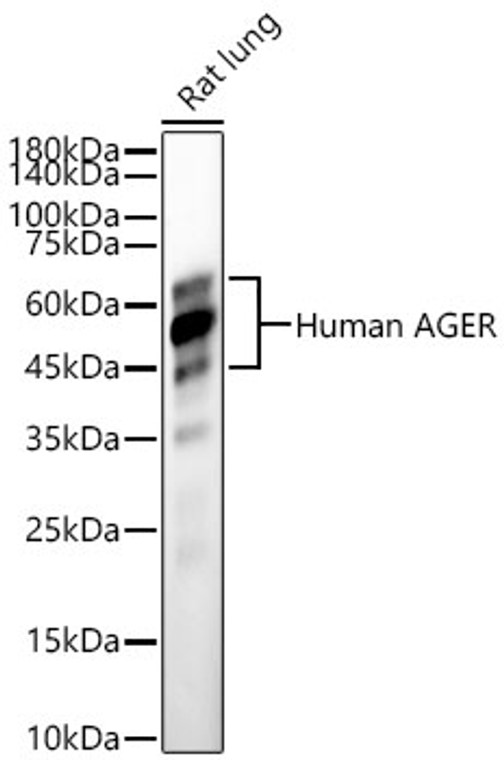| Host: |
Rabbit |
| Applications: |
WB |
| Reactivity: |
Human/Mouse/Rat |
| Note: |
STRICTLY FOR FURTHER SCIENTIFIC RESEARCH USE ONLY (RUO). MUST NOT TO BE USED IN DIAGNOSTIC OR THERAPEUTIC APPLICATIONS. |
| Short Description: |
Rabbit polyclonal antibody anti-Advanced Glycosylation End Product-Specific Receptor (24-344) is suitable for use in Western Blot research applications. |
| Clonality: |
Polyclonal |
| Conjugation: |
Unconjugated |
| Isotype: |
IgG |
| Formulation: |
PBS with 0.05% Proclin300, 50% Glycerol, pH7.3. |
| Purification: |
Affinity purification |
| Dilution Range: |
WB 1:500-1:1000 |
| Storage Instruction: |
Store at-20°C for up to 1 year from the date of receipt, and avoid repeat freeze-thaw cycles. |
| Gene Symbol: |
AGER |
| Gene ID: |
177 |
| Uniprot ID: |
RAGE_HUMAN |
| Immunogen Region: |
24-344 |
| Immunogen: |
Recombinant fusion protein containing a sequence corresponding to amino acids 24-344 of human AGER (NP_001127.1). |
| Immunogen Sequence: |
QNITARIGEPLVLKCKGAPK KPPQRLEWKLNTGRTEAWKV LSPQGGGPWDSVARVLPNGS LFLPAVGIQDEGIFRCQAMN RNGKETKSNYRVRVYQIPGK PEIVDSASELTAGVPNKVGT CVSEGSYPAGTLSWHLDGKP LVPNEKGVSVKEQTRRHPET GLFTLQSELMVTPARGGDPR PTFSCSFSPGLPRHRALRTA PIQPRVWEPVPLEEVQLVVE PEGGAVAPGGTVTLTCEVP |
| Tissue Specificity | Endothelial cells. |
| Post Translational Modifications | Phosphorylated on its cytoplasmic domain by PKCzeta/PRKCZ upon ligand binding. Targeted by the ubiquitin E3 ligase subunit FBXO10 to mediate its ubiquitination and degradation. |
| Function | Cell surface pattern recognition receptor that senses endogenous stress signals with a broad ligand repertoire including advanced glycation end products, S100 proteins, high-mobility group box 1 protein/HMGB1, amyloid beta/APP oligomers, nucleic acids, phospholipids and glycosaminoglycans. Advanced glycosylation end products are nonenzymatically glycosylated proteins which accumulate in vascular tissue in aging and at an accelerated rate in diabetes. These ligands accumulate at inflammatory sites during the pathogenesis of various diseases, including diabetes, vascular complications, neurodegenerative disorders, and cancers and RAGE transduces their binding into pro-inflammatory responses. Upon ligand binding, uses TIRAP and MYD88 as adapters to transduce the signal ultimately leading to the induction or inflammatory cytokines IL6, IL8 and TNFalpha through activation of NF-kappa-B. Interaction with S100A12 on endothelium, mononuclear phagocytes, and lymphocytes triggers cellular activation, with generation of key pro-inflammatory mediators. Interaction with S100B after myocardial infarction may play a role in myocyte apoptosis by activating ERK1/2 and p53/TP53 signaling. Contributes to the translocation of amyloid-beta peptide (ABPP) across the cell membrane from the extracellular to the intracellular space in cortical neurons. ABPP-initiated RAGE signaling, especially stimulation of p38 mitogen-activated protein kinase (MAPK), has the capacity to drive a transport system delivering ABPP as a complex with RAGE to the intraneuronal space. Participates in endothelial albumin transcytosis together with HMGB1 through the RAGE/SRC/Caveolin-1 pathway, leading to endothelial hyperpermeability. Mediates the loading of HMGB1 in extracellular vesicles (EVs) that shuttle HMGB1 to hepatocytes by transferrin-mediated endocytosis and subsequently promote hepatocyte pyroptosis by activating the NLRP3 inflammasome. Promotes also extracellular hypomethylated DNA (CpG DNA) uptake by cells via the endosomal route to activate inflammatory responses. |
| Protein Name | Advanced Glycosylation End Product-Specific ReceptorReceptor For Advanced Glycosylation End Products |
| Database Links | Reactome: R-HSA-445989Reactome: R-HSA-879415Reactome: R-HSA-933542 |
| Cellular Localisation | Isoform 1: Cell MembraneSingle-Pass Type I Membrane ProteinIsoform 2: SecretedIsoform 10: Cell Membrane |
| Alternative Antibody Names | Anti-Advanced Glycosylation End Product-Specific Receptor antibodyAnti-Receptor For Advanced Glycosylation End Products antibodyAnti-AGER antibodyAnti-RAGE antibody |
Information sourced from Uniprot.org
12 months for antibodies. 6 months for ELISA Kits. Please see website T&Cs for further guidance







